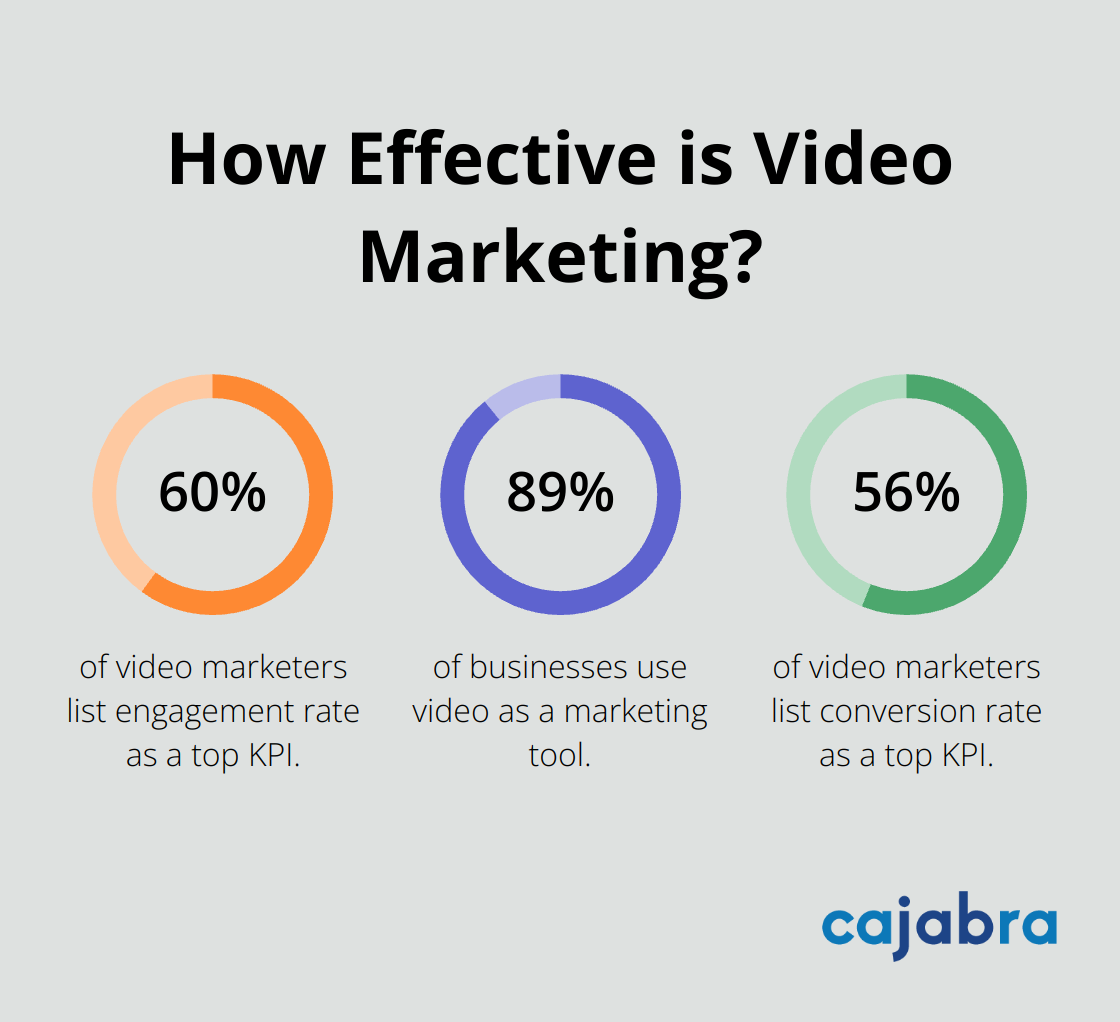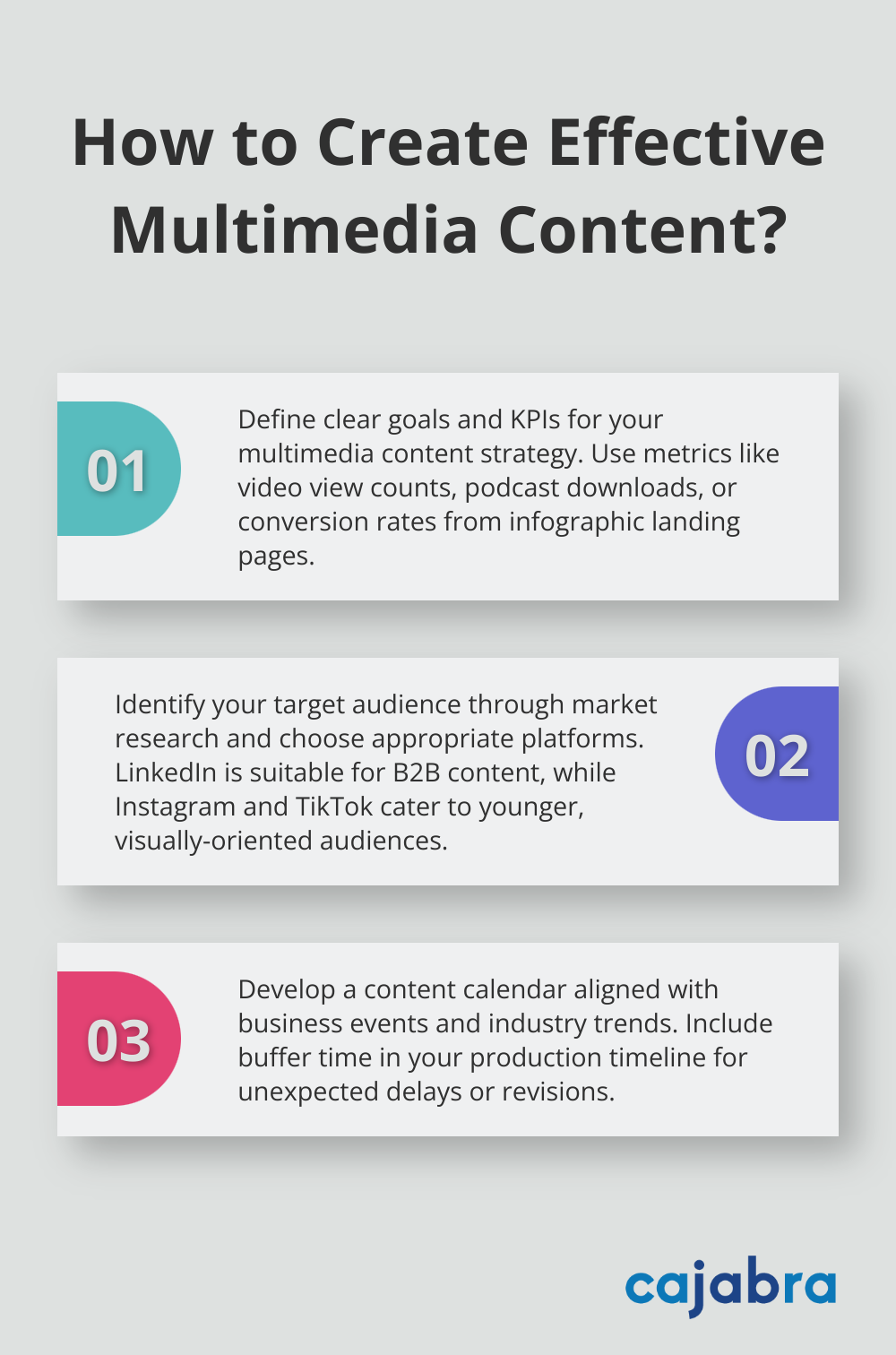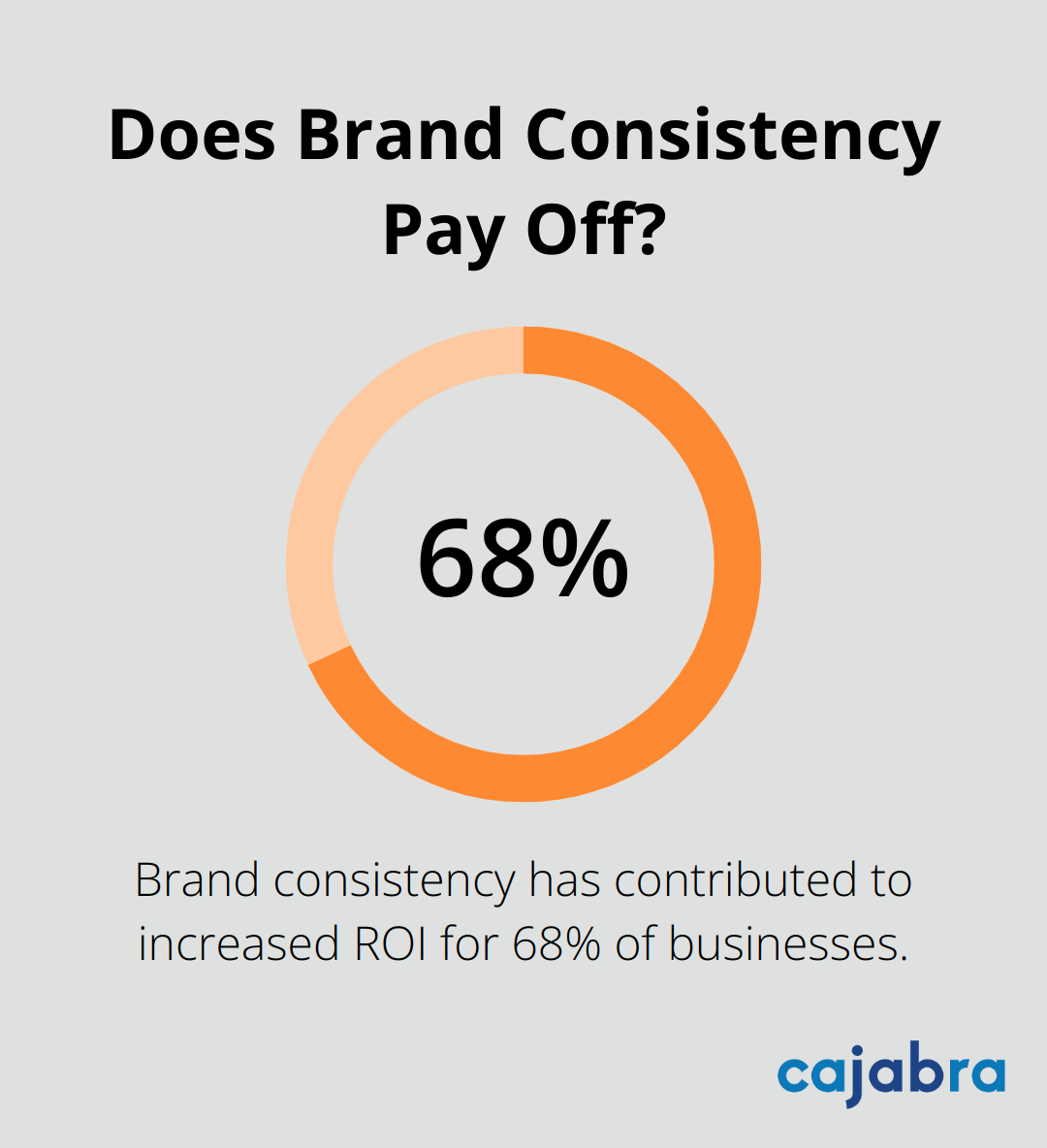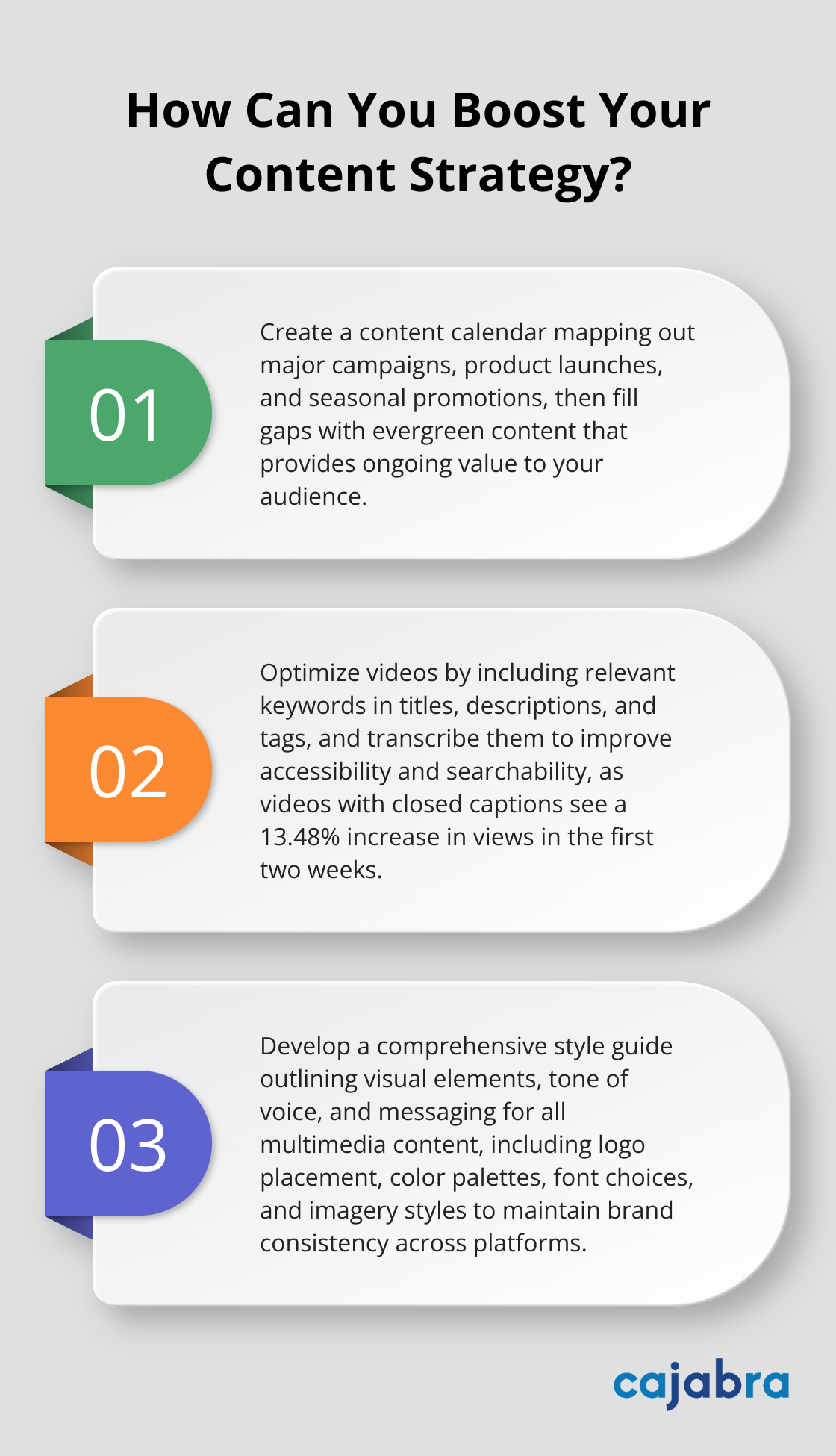
Multimedia content marketing is reshaping how businesses connect with their audience. At Cajabra, LLC, we've seen firsthand the power of combining various media types to create compelling campaigns.
This blog post will guide you through the essentials of crafting effective multimedia content that resonates with your target market. We'll cover everything from strategy planning to best practices for engaging your audience across different platforms.
Multimedia content marketing combines various media forms to engage audiences and deliver messages effectively. This strategy uses a mix of content types - videos, podcasts, images, and infographics - to tell a brand's story and connect with target markets.
Video content stands as a cornerstone of effective marketing strategies. According to HubSpot's marketing statistics, 60% of video marketers list engagement rate as a top KPI, followed by conversion rate (56%) and click-through rate (52%). This highlights the power of visual storytelling in capturing audience attention and driving engagement.

Audio content (particularly podcasts) has experienced a surge in popularity. Podcasts offer a unique way to connect with audiences, allowing for in-depth discussions and personal connections that text-based content often can't match. For B2B marketers, podcasts serve as an excellent tool to establish thought leadership and build trust with potential clients.
Infographics simplify complex data and make it more digestible for audiences. Their high shareability on social media platforms makes them an excellent choice for increasing brand visibility. When creating infographics, clear data visualization enhances comprehension and retention of key information.
A successful multimedia content marketing strategy leverages multiple platforms to reach audiences where they are. This approach might include YouTube for video content, social media for short-form videos and images, and websites for longer-form content (like blog posts and infographics).
Wyzowl's report indicates that 89% of businesses use video as a marketing tool, reflecting its importance across various platforms. This multi-platform approach allows for content repurposing across different formats, reaching diverse audience segments and maximizing marketing efforts' impact.
Tracking performance metrics ensures the effectiveness of multimedia content marketing efforts. This practice allows for strategy adjustments based on audience preferences and engagement levels. Key metrics to monitor include video view counts, podcast download numbers, infographic shares, and overall engagement rates across platforms.
The next chapter will explore how to plan and execute a comprehensive multimedia content strategy that aligns with your business goals and resonates with your target audience.
Set clear, measurable goals for your multimedia content. Determine if you want to increase brand awareness, generate leads, or drive sales. Each goal requires a different approach. For lead generation, you might create gated content like webinars or downloadable guides.

Establish KPIs to track progress. These may include video view counts, podcast download numbers, or conversion rates from infographic landing pages.
Conduct market research to determine demographics, interests, and pain points of your audience. This information will guide your content creation and platform selection.
Different platforms cater to various audience segments. LinkedIn works well for B2B content, while Instagram and TikTok suit younger, visually-oriented audiences.
Create a well-structured content calendar to ensure consistent output and align your multimedia efforts with key business events or industry trends. Map out major campaigns, product launches, or seasonal promotions. Fill in the gaps with evergreen content that provides ongoing value to your audience.
Your production timeline should factor in the time required for each content type. Video production typically takes longer than creating static images or writing blog posts. Include buffer time for unexpected delays or revisions.
Multimedia content often requires specialized skills and equipment. Assess your in-house capabilities and determine where you might need to outsource. Video production, for instance, might require professional videographers or editors.
When budgeting, consider the potential return on investment for each content type. While video content can cost more to produce, it often yields higher engagement rates.
Allocate budget for content distribution as well. Even the best content needs promotion to reach its intended audience. This might include paid social media advertising, influencer partnerships, or sponsored content placements.
A robust multimedia content strategy drives engagement and supports your business objectives. The next section will explore best practices for creating compelling multimedia content across various formats, ensuring your efforts resonate with your target audience and achieve maximum impact.
Visual storytelling forms the foundation of effective multimedia content. For videos, capture attention with a strong hook in the first few seconds. On TikTok, videos of 15-60 seconds are preferred, so keep your content concise and impactful. Use a mix of wide shots and close-ups to create visual interest and guide the viewer's focus.

For infographics, structure your information in a logical flow. Start with a compelling title and use a consistent color scheme that aligns with your brand. Limit text and focus on visual representations of data. Infographics are liked and shared on social media 3x more than any other type of content, making them a powerful tool for engagement.
To maximize the reach of your multimedia content, focus on optimization. For videos, include relevant keywords in titles, descriptions, and tags. Transcribe your videos to improve accessibility and searchability. Videos with closed captions see a 13.48% increase in views in the first two weeks.
For social media, tailor your content to each platform's specifications. Instagram favors square images and short-form videos, while LinkedIn prefers landscape formats for images and longer-form video content. Use platform-specific features (like Instagram Stories or LinkedIn Articles) to boost engagement.
With over 50% of global web traffic coming from mobile devices, mobile optimization is essential. Ensure your videos play well on smaller screens by using larger text and clear visuals. For infographics, create mobile-friendly versions that are easy to scroll through on smartphones.
Make accessibility a top priority. Include alt text for images, provide transcripts for audio content, and use high-contrast color schemes in your visuals. This approach not only makes your content more inclusive but also improves your SEO performance.
Consistent branding across all multimedia content strengthens brand recognition and trust. Develop a style guide that outlines your brand's visual elements, tone of voice, and messaging. This guide should cover everything from logo placement and color palettes to font choices and imagery styles.
For videos, try creating branded intros and outros. These short segments can significantly boost brand recall. For infographics and images, incorporate your logo subtly but consistently. Brand consistency has contributed to increased ROI for 68% of businesses.
Multimedia content marketing stands as a cornerstone of effective digital strategies. It combines various media types to create engaging, informative, and shareable content that resonates with target audiences. The key to success lies in careful planning, consistent execution, and ongoing analysis of your multimedia content marketing efforts.

We at Cajabra have observed how effective multimedia content marketing can transform businesses. Our specialized marketing services help firms attract ideal clients and boost their online presence. These strategies can significantly improve brand visibility and engagement.
Start to implement these multimedia content marketing strategies today. You will create compelling content that reaches your target audience and drives meaningful business results. With the right approach, your brand will stand out in a crowded market and achieve its marketing goals.



